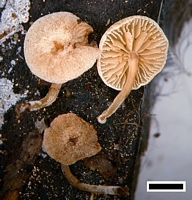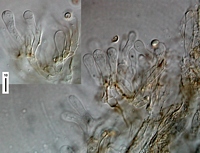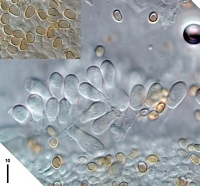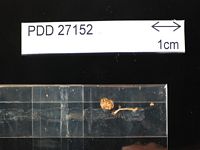|
 Simocybe austrorubi Simocybe austrorubi
SynonymsRamicola austrorubi
BiostatusPresent in region - Indigenous. Non endemic
Images (click to enlarge) | 
Caption: scale=2mm
Owner: J.A. Cooper | 
Caption: pilocystidia (hymeniderm!)
Owner: J.A. Cooper | 
Caption: fascicle of cheilocystidia and spores
Owner: J.A. Cooper | 
Caption: Dried type specimen
Owner: Herb PDD |
Article: Horak, E. (1980). Fungi Agaricini Novazelandiae. X. Simocybe Karsten. New Zealand Journal of Botany 18(2): 189–196 (http://www.rsnz.org/publish/abstracts.php).
Description: Pileus -10 mm, convex when young soon becoming plane or subconcave, margin upturned, distinct conic papilla or umbo at centre; pale brown to argillaceous; pruinose all over, dry, hygrophanous, striate towards margin, veil remnants absent. Lamellae (L 18-10, -5) moderately crowded, adnate to broadly adnate, occasionally emarginate in aged specimens; whitish when young, turning pale brown, edge albofimbriate, serrate. Stipe -15 x -1 mm, cylindric, central, equal; concolorous with pileus; conspicuously pruinose over entire length, dry, solid, single in groups, veil remnants none. Odour and taste not distinctive. Context pale brown, Spore print brown. Spores 6-7.5 x 4-4.5 µm, ovoid to subphaseoliform, brown, membrane thin-walled, smooth, germ pore absent. Basidia 25-30 x 6-7 µm, 4-spored. Cheilocystidia 30-50 x 7-10 µm, clavate, membrane thin-walled, hyaline, pigment absent, clamp connection on basal septum. Pleurocystidia none. Caulocystidia like cheilocystidia. Cuticle a palisade of erect, clavate cells (15-40 x 3-8 µm), membrane smooth or encrusted with pale brown (KOH) pigment, not gelatinised. Clamp connections numerous.
Habitat: o n soil in broad-leaved forest (dominated by Weinmannia, Dacrydium, and Fuchsia excorticata (J. R. et G. Forst.) Hook.f. New Zealand.
Notes: The epithet given to this small and inconspicuous agaric indicates a close taxonomic-morphologic relationship to the European Simocybe rubi (Berkeley) Singer. In addition, Simocybe argillacea Horak (1979b) and its 2-spored form (f. bispora Horak 1979b), both reported from Papua New Guinea, also must be considered to be related. The New Zealand species, however, is readily separated from the two neighboring taxa by the following features: absence of olive colours on the carpophores, size of the spores, number of sterigmata on the basidia, and shape of the cheilo- and caulocystidia.
|